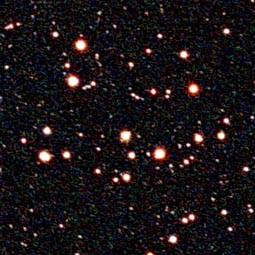Coma Berenices
Coma Berenices is a fairly small constellation situated between Leo and Bootes. It has no star brighter than the fourth magnitude, but most of the stars it does possess congregate together in a star cluster which is a quite conspicuous and pleasing sight to the naked eye or with binoculars on Spring evenings. The Coma star cluster was considered at one time to be just a part of the neighbouring constellation of Leo (the tuft at the end of his tail in fact!), and at another time as part of Virgo. The origins of Coma Berenices as an independent constellation however date well back into antiquity. It is named in honour of an Egyptian queen from the 3rd century B.C., or more precisely, her golden tresses. Despite the fact that it is one of the nearest and brightest galactic (or open) clusters the Coma star cluster is not recorded in either of the Messier or New General Catalogues. Instead it is listed as the 111th object in the rather more obscure Melotte catalogue.
Coma star cluster
What Coma Berenices lacks in bright stars it makes up for in terms of galaxies. Many members of the Virgo cluster lie on the Coma side of the Coma/Virgo border. These include the Messier objects numbered 85, 88, 91, 98, 99 & 100. Messier 91 is of historical interest since it was considered for a long time to be one of the so-called “missing” Messier objects. Nowadays however it is thought to be one and the same object as NGC 4548 which shares the same low power field as M88. The brightest galaxy in Coma though is M64, the “Black Eye” galaxy. M64 is bright enough to be spotted in binoculars, and larger telescopes should detect a hint of the dark central dust clouds for which it is named. M64 is probably too close to us to be considered a true member of the Virgo cluster, and the same can be said for NGC 4565, an archetypal edge-on spiral galaxy.
For something a bit more challenging, try 13th magnitude NGC 4889, which is the brightest member of the Coma galaxy cluster. The Coma cluster should not be confused with the Virgo cluster. It is in fact about ten times more distant at 400 million light years. If you do manage to glimpse this very distant galaxy you might care to contemplate the fact that when the light you are receiving started its journey, our ancestors were yet to crawl from the sea; and also that the largest telescopes are now searching for objects some 20 – 30 times more distant!
Coma also boasts a nice globular cluster in M53. One degree away from M53, the rather more sparse and faint globular NGC 5053 provides an interesting contrast.
POWERPOINT SLIDE SHOW (265KB)